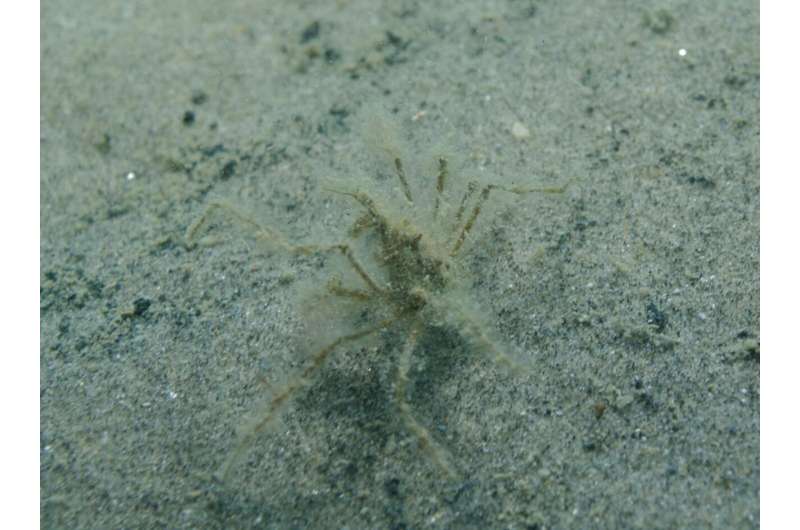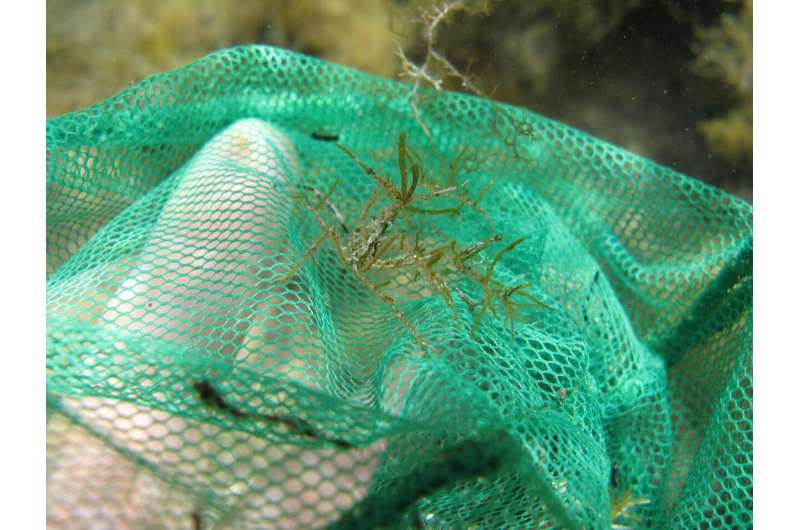Macropodia czernjawskii in the wild, Bugazskaya kosa (near Anapa), Caucasus, Black Sea. Credit: Sergey Anosov
Even though recognised in the Mediterranean Sea, the Macropodia czernjawskii spider crab was ignored by scientists (even by its namesake Vladimir Czernyavsky) in the regional faunal accounts of the Black Sea for more than a century. At the same time, although other species of the genus have been listed as Black Sea fauna, those listings are mostly wrong and occurred either due to historical circumstances or misidentifications.
Now, scientists re-describe this, most likely, only species of the genus occurring in the Black Sea in the open-access journal Zoosystematics and Evolution.
The spider crab genus Macropodia was discovered in 1814 and currently includes 18 species, mostly occurring in the Atlantic and the Mediterranean. The marine fauna of the Black Sea is predominantly of Mediterranean origin and Macropodia czernjawskii was firstly discovered in the Black Sea in 1880, but afterwards, its presence there was largely ignored by the scientists.
After the revision of available type specimens from all available collections in the Russian museums and the Senckenberg Museum in Frankfurt-on-Main, as well as newly collected material in the Black Sea and the North-East Atlantic, a research team of scientists, led by Dr. Vassily Spiridonov from Shirshov Institute of Oceanology of Russian Academy of Sciences, re-described Macropodia czernjawskii and provided the new data on its records and updated its ecological characteristics.
"The analysis of the molecular genetic barcode (COI) of the available material of Macropodia species indicated that M. czernjawskii is a very distinct species while M. parva should be synonimised with M. rostrata, and M. longipes is a synonym of M. tenuirostris", states Dr. Spiridonov sharing the details of the genus analysis.
Macropodia czernjawskii in wild, Tuaphat (near Gelendzhik), Caucasus, Black Sea. Credit: Sergey Anosov
All Macropodia species have epibiosis and M. czernjawskii is no exception: almost all examined crabs in 2008-2018 collections had significant epibiosis. It normally consists of algae and cyanobacteria and, particularly, a non-indigenous species of red alga Bonnemaisonia hamifera, officially reported in 2015 at the Caucasian coast of the Black Sea, was found in the epibiosis of M. czernjawskii four years earlier.
Macropodia czernjawskii spider crab in the wild, Tuaphat (near Gelendzhik), Caucasus, Black Sea Credit: Sergey Anosov
"It improves our understanding of its invasion history. Museum and monitoring collections of species with abundant epibiosis (in particular inachid crabs) can be used as an additional tool to record and monitor introduction and establishments of sessile non-indigenous species," suggests Dr. Spiridonov.
More information: Bee Yan Lee et al, Revision of the deep-water spider crab genus, Scyramathia A. Milne-Edwards, 1880, with the description of a new species from the Mediterranean and notes on Rochinia A. Milne-Edwards, 1875, and Anamathia Smith, 1885 (Crustacea, Decapoda, Brachyura, Epialtidae), Zoosystematics and Evolution (2020). DOI: 10.3897/zse.96.48041
Provided by Pensoft Publishers

























